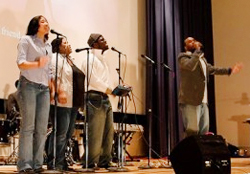
3) Back off the lows. Again with a shelf filter so they aren’t clogging up the instruments while at the same time, not sounding too flat.
4) Separate and blend with reverb. First, use a different type of reverb than the lead vocal. The lead vocal would be good with a short reverb time while the backing vocals can be blended together with a longer reverb like a Hall reverb.
5) Compress them. They will be fitting in the mix in a very tight space and you don’t want a backing vocalist to suddenly sound louder than the others…especially the lead singer. Use a higher compression ratio if necessary, especially if you have one singer who really likes to belt them out.
6) Actively mix them. Blending is more than setting the initial volume levels, setting the EQ, and putting on some reverb. Place the backing vocalists into a group and control all of their volumes with one fader. Then, you can easily cut or boost their volume so they are always in the right relationship in the mix.
If the lead singer lets the backing vocalists take over for the chorus, then you can easily boost their volume. You can also boost their vocals at a point in the song when a verse has a punched up line that stands out. This is where it helps to listen to professional recordings of the same songs during the week.
7) Blend the vocalists together. You aren’t creating three distinct sounds for the three backing vocalists. You are creating a single sound. Cut and boost frequencies so they sound as one.
Looking beyond the highs and lows, consider these frequencies as a place to start:
150 Hz – 600 Hz: Warmth
500 Hz – 2 kHz: Nasal (cut to eliminate)
3 kHz – 5 kHz: Sibilance (cut to eliminate)
1.5 kHz – 8 kHz: Clarity and Presence
The Take Away
All vocalists on the stage shouldn’t be singing at the same volume level. They shouldn’t all sound distinct. Backing vocalists can be used in multiple ways depending on the song arrangement. They aren’t used to sound like a duplicate of the lead singer.
Consider the group as an instrument when in one song, they are a blended rhythm guitar, and in another song, they are the highlighted lead instrument.
Ready to learn and laugh? Chris Huff writes about the world of church audio at Behind The Mixer. He covers everything from audio fundamentals to dealing with musicians, and can even tell you the signs the sound guy is having a mental breakdown. To view the original article and to make comments, go here.
